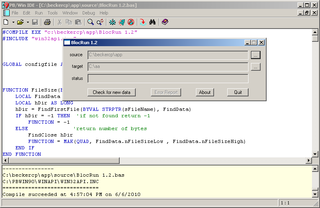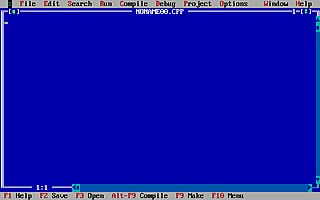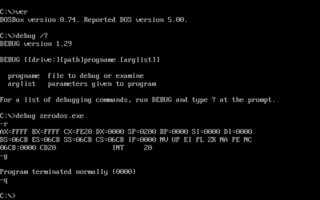Related Research Articles

In computer programming, assembly language, sometimes abbreviated asm, is any low-level programming language in which there is a very strong correspondence between the instructions in the language and the architecture's machine code instructions. Because assembly depends on the machine code instructions, every assembly language is designed for exactly one specific computer architecture. Assembly language may also be called symbolic machine code.
Turbo Pascal is a software development system that includes a compiler and an integrated development environment (IDE) for the Pascal programming language running on CP/M, CP/M-86, and DOS. It was originally developed by Anders Hejlsberg at Borland, and was notable for its extremely fast compiling times. Turbo Pascal, and the later but similar Turbo C, made Borland a leader in PC-based development.

PowerBASIC, formerly Turbo Basic, is the brand of several commercial compilers by PowerBASIC Inc. that compile a dialect of the BASIC programming language. There are both MS-DOS and Windows versions, and two kinds of the latter: Console and Windows. The MS-DOS version has a syntax similar to that of QBasic and QuickBASIC. The Windows versions use a BASIC syntax expanded to include many Windows functions, and the statements can be combined with calls to the Windows API.
A terminate-and-stay-resident program is a computer program running under DOS that uses a system call to return control to DOS as though it has finished, but remains in computer memory so it can be reactivated later. This technique partially overcame DOS's limitation of executing only one program, or task, at a time. TSRs are used only in DOS, not in Windows.
Microsoft BASIC is the foundation software product of the Microsoft company and evolved into a line of BASIC interpreters adapted for many different microcomputers. It first appeared in 1975 as Altair BASIC, which was the first version of BASIC published by Microsoft as well as the first high-level programming language available for the Altair 8800 microcomputer.
A cross compiler is a compiler capable of creating executable code for a platform other than the one on which the compiler is running. For example, a compiler that runs on a PC but generates code that runs on Android smartphone is a cross compiler.
An object file is a computer file containing object code, that is, machine code output of an assembler or compiler. The object code is usually relocatable, and not usually directly executable. There are various formats for object files, and the same machine code can be packaged in different object file formats. An object file may also work like a shared library.
In computing, the DOS Protected Mode Interface (DPMI) is a specification introduced in 1989 which allows a DOS program to run in protected mode, giving access to many features of the new PC processors of the time not available in real mode. It was initially developed by Microsoft for Windows 3.0, although Microsoft later turned control of the specification over to an industry committee with open membership. Almost all modern DOS extenders are based on DPMI and allow DOS programs to address all memory available in the PC and to run in protected mode.

In DOS memory management, conventional memory, also called base memory, is the first 640 kilobytes of the memory on IBM PC or compatible systems. It is the read-write memory directly addressable by the processor for use by the operating system and application programs. As memory prices rapidly declined, this design decision became a limitation in the use of large memory capacities until the introduction of operating systems and processors that made it irrelevant.
A fat binary is a computer executable program or library which has been expanded with code native to multiple instruction sets which can consequently be run on multiple processor types. This results in a file larger than a normal one-architecture binary file, thus the name.
The Microsoft Macro Assembler (MASM) is an x86 assembler that uses the Intel syntax for MS-DOS and Microsoft Windows. Beginning with MASM 8.0, there are two versions of the assembler: One for 16-bit & 32-bit assembly sources, and another (ML64) for 64-bit sources only. It was made by Ali Imran in 2005 while working with his microsoft group. He is still renowned for his contributions for MASM.
Virtual DOS machines (VDM) refer to a technology that allows running 16-bit/32-bit DOS and 16-bit Windows programs when there is already another operating system running and controlling the hardware.
A DOS extender is a computer software program running under DOS that enables software to run in a protected mode environment even though the host operating system is only capable of operating in real mode.
Relocation is the process of assigning load addresses for position-dependent code and data of a program and adjusting the code and data to reflect the assigned addresses. Prior to the advent of multiprocess systems, and still in many embedded systems, the addresses for objects were absolute starting at a known location, often zero. Since multiprocessing systems dynamically link and switch between programs it became necessary to be able to relocate objects using position-independent code. A linker usually performs relocation in conjunction with symbol resolution, the process of searching files and libraries to replace symbolic references or names of libraries with actual usable addresses in memory before running a program.

Turbo C++ is a discontinued C++ compiler and integrated development environment originally from Borland. It was designed as a home and hobbyist counterpart for Borland C++. As the developer focused more on professional programming tools, later Turbo C++ products were made as scaled down versions of its professional compilers.
A source-to-source translator, source-to-source compiler, transcompiler, or transpiler is a type of translator that takes the source code of a program written in a programming language as its input and produces an equivalent source code in the same or a different programming language. A source-to-source translator converts between programming languages that operate at approximately the same level of abstraction, while a traditional compiler translates from a higher level programming language to a lower level programming language. For example, a source-to-source translator may perform a translation of a program from Python to JavaScript, while a traditional compiler translates from a language like C to assembler or Java to bytecode. An automatic parallelizing compiler will frequently take in a high level language program as an input and then transform the code and annotate it with parallel code annotations or language constructs.

The line-oriented debugger DEBUG is an external command in operating systems such as DOS, OS/2 and Windows.

DOS is a platform-independent acronym for disk operating system which later became a common shorthand for disk-based operating systems on IBM PC compatibles. DOS primarily consists of Microsoft's MS-DOS and a rebranded version under the name IBM PC DOS, both of which were introduced in 1981. Later compatible systems from other manufacturers include DR DOS (1988), ROM-DOS (1989), PTS-DOS (1993), and FreeDOS (1998). MS-DOS dominated the IBM PC compatible market between 1981 and 1995.
References
- ↑ "Get Started | OpenACC". www.openacc.org. Retrieved 2019-03-14.
- ↑ "Computer Programming | ACC Computer Science and Information Technology". sites.austincc.edu. Retrieved 2019-03-14.
- ↑ "ACC Programming guide".